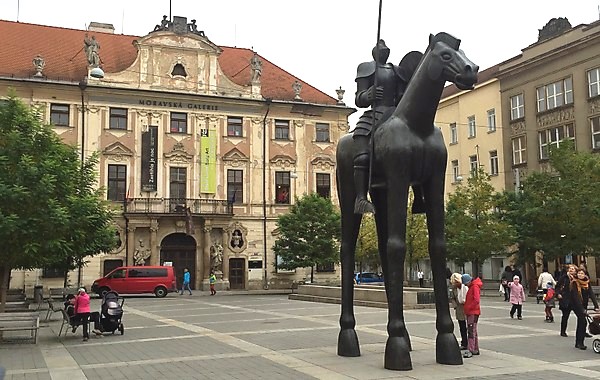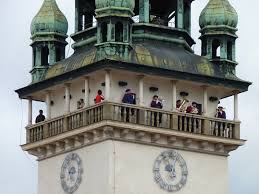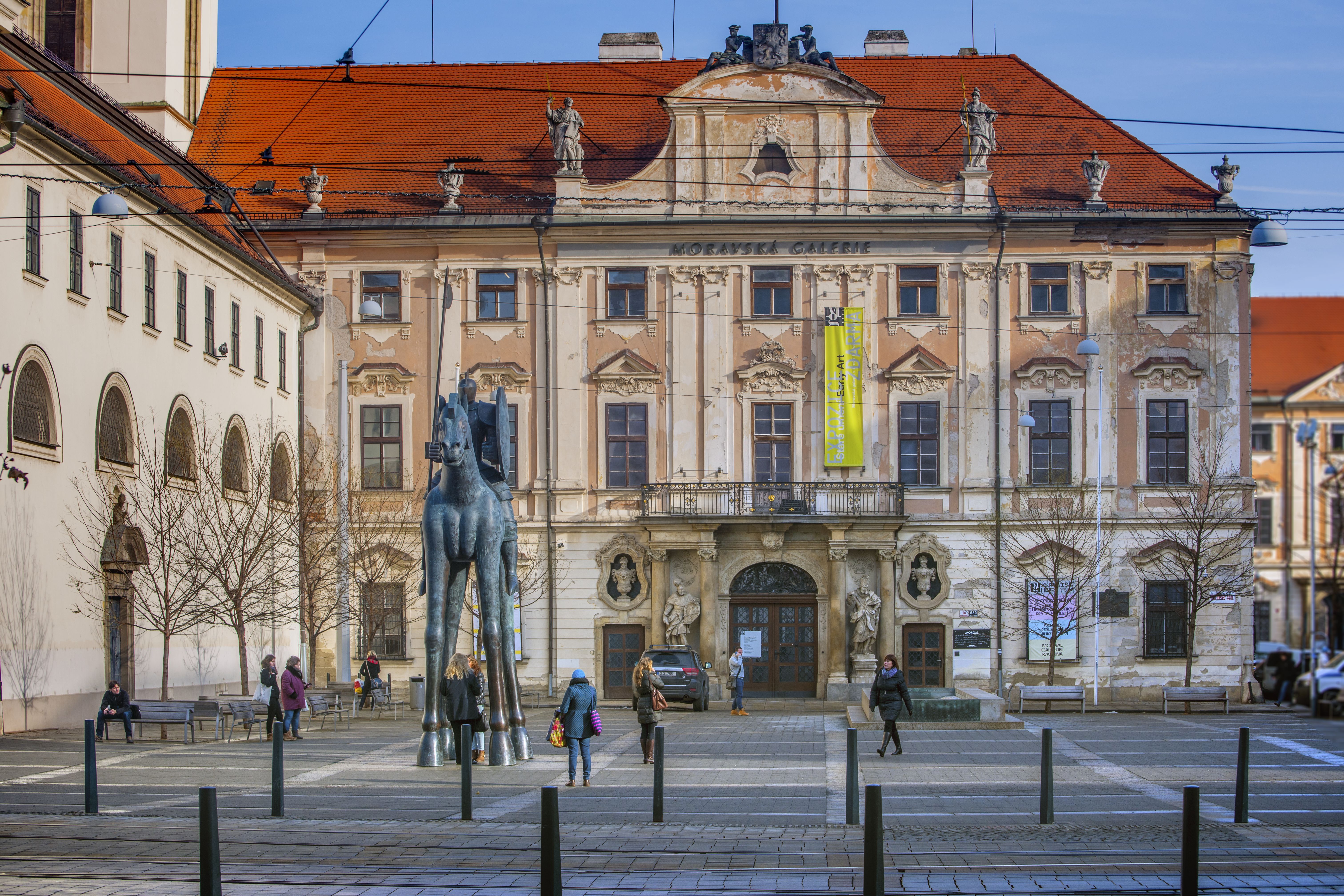Through Brno: Thought-provoking public art

When I started as a journalist, I worked in a small town on the Puget Sound in Washington State in America. It was an old fishing village that had turned into a southern Seattle suburb. The only fishing at the time was recreational, but, in a moment of nostalgic inspiration, the town council decided to commission a statue. (Also, they needed something in the small area created by new road construction that improved traffic-flow to a supermarket.)
The statue commemorates a legend: a fisherman’s lover was changed into a fish by an evil witch, then changed back when he finally caught and kissed her. The statue is of a two-meter-tall fisherman, bending backward in the loving embrace of an equally large fish. He has one leg in the air, and it nicely captures the amorous moment of reunion.
The sculptor, however, added a small touch. Two of them, in fact, and they aren’t really small, either. If you look under the fins, you can see the fisherman’s hands cupped around female human breasts. Suffice it to say, the small-scale replica that had been shown to the town council did not have breasts.
When the cover came off during the unveiling ceremony, people were shocked. The church ladies wanted the breasts chiseled off; the grunge musicians wanted to add fashionable-at-the-time nipple rings; the hippies wanted the breasts more prominent and proud, and teenage boys just wanted to see them.
***
Brno has spent millions of crowns on public artwork in the past few years, and it has been experiencing a similar kind of public debate. This should not be surprising for a town that proudly tells the story of the disgruntled sculptor who twisted the middle spire of the entrance to Old Town Hall or that points out the little angel on St. James church that is flashing its bare ass at St. Petr and Paul Cathedral as part of an architectural rivalry.
Nevertheless, ask any local, and they surely have an opinion about the orloj on náměstí Svobody. The black, six-meter-tall, bullet-shaped, rounded obelisk has been a lightning rod from the moment it was introduced in 2010. In this case, it’s not female breasts; it’s (perhaps) a male… phallus. And it’s not hidden.

Many people agree with the suggestion that it is a large penis, and that is, admittedly, a tough image to erase. (Protecting it with a condom-looking sleeve when Kometa playoff games are broadcast in the square doesn’t help.) It’s safe to say that the overwhelming majority of people do not care for the “Brno astronomical clock”.
There is, however, a small faction who respect the ideas behind the monument. Notice, I said monument. And here are some reasons to like it:
1. It is not meant to be a clock; it’s a granite monument.
2. The monument depicts the disorienting time-telling that, according to a legend, saved Brno from the Swedish army during the Thirty Years War. In 1645, after a monthslong siege, the Swedes were tired and annoyed. Finally, Field Marshal Lennart Torstensson set a deadline: if the city walls are not breached by the noon bells, the army will move on. Locals caught wind of the plan, barely held on (with stiff resistance), and cleverly rang the noon bell an hour early. Brno was saved. It wouldn’t make sense to have an easy-to-read clock face.
3. The monument was unveiled on Sept. 18, 2010, to mark the 365th anniversary of the resistance. It makes sense, therefore, to have a 24-hour band that spins exactly once per day.
4. There is a daily souvenir to further commemorate that historical moment. At 11 a.m. – Brno’s noon – the statue delivers a glass marble to one of four holes. You have to be there in time to get a place; you have to be at the correct hole, and you have to catch it. In other words, you have to earn it.
5. The overall shape is definitely phallic. What’s wrong with that? It means power, potency, dominance.
6. The shape is also representative of the most basic type of ammunition throughout the centuries. And, by the way, a nice connection to the largely male habit of getting into pissing contests that lead to wars.
7. The current time is available on the clock, but it requires a bit of understanding and patience. Are you really in such a big hurry? Perhaps you should slow down, smell the roses, appreciate the historic city center.
8. Who wants another traditional clock? This time-piece has its mechanism shifted 90 degrees toward the sky and rotates on a horizontal plane.
9. Is another place to get the time really necessary? We have watches, phones, tablets, and the digital scroll on the tram. Look at your receipt from Albert for an approximate time. Or just look at the church steeple to the north.
10. Prague and Olomouc already have impressive astronomical clocks. It would have been lame to create a similar version.
11. The monument provides a nice middle ground within the surrounding architectural mishmash, fitting in with the traditional buildings and the post-Communist-era Omega building.
12. It is a logical place to meet because there is a lot of space.
13. It has sparked many a beer-fueled conversation.
14. And, it is fun to listen to the scandalized seniors.
***
The most recent addition to Brno public art is a statue on Moravské náměstí (near the Brno Expat Centre) in honor of Margrave Jošt of the Luxembourg Dynasty (1351-1411) who is burried in the nearby St. Thomas church. It is a knight sitting on a horse and holding a spear that reaches eight meters above the ground. Both the knight and the long-legged horse are black and ready for battle. They look tough.
The equestrian statue, however, has again riled up a significant portion of the citizenry. It was quickly dismissed as The Giraffe. Before it was officially unveiled last September, a late-night visitor had already attempted to climb it and ended up in the hospital. And, within hours of the unveiling someone had found the perfect angle to make the horse’s head look like a phallus.
To me, it is like the cherry on top of the recent reconstruction of the Česká tram stop. Jošt – sometimes written in English as Jobst of Moravia – is a powerful reminder of the medieval history of Brno. He was the nephew of Karel “Charles Bridge” IV. According to Wikipedia, he was King of the Romans (and just the Pope’s blessing away from becoming Emperor and making Brno the center of the Holy Roman Empire); Margrave of Moravia (with his headquarters in Špilberk Castle); Margrave of Lusatia and Brandenburg; Elector of Brandenburg; Duke of Luxembourg; Vicarius of Italy; and Vicarius of the Holy Roman Empire. Pretty cool for a local boy.
I like that he is not afraid to suit up and kick some ass. His statue has impressive musculature and smooth lines. The armor and details are stripped down to convey power. He is watching over the city, protecting it.
***
Jošt is meant to complete the Four Virtues of Plato. The inverted fountain directly in front of the Moravian Gallery represents Temperance, the nearby 3-D map of Thirty Years War-era Brno represents Wisdom, and Jošt represents Courage.
Personally, my favorite statue is the fourth virtue: Justice. It is across the street, in front of the Supreme Administrative Court, and it depicts a round-shouldered man, straining to pick up a large block. The athletic, slanting position of the man imbues the statue with innate force. The water flowing upward from underneath the block adds significance to the task.

This was the natural location for the Justice 300 memorial last year when panels of black and white photos completely surrounded the statue to commemorate the 300 Brno Jews who were murdered during World War II. People were required to duck under the panels (read: make an effort to understand) and the photos were printed with slowly disappearing ink (read: symbolic of the once large Jewish community in Brno.)
(Full disclosure: Justice was created by Marius Kotrba. The Moravian sculptor had been commissioned to add a total of 10 sculptures to the streets of Brno, including the Jošt statue. Tragically, he died five years ago, a month before he was to host a series of lectures in Brno about public art. His studio was in the space where my mother was born and raised in Rožnov pod Radhoštěm.)
Some say that Justice, given that it is right in front of the courthouse, depicts the repossession man removing the final shards of dignity from a home.
My favorite interpretation is that it commemorates the ending of “One Flew Over the Cuckoo’s Nest”, the book by Ken Kesey and the 1975 movie by Czech director Miloš Forman that won Academy Awards for best picture, director, actor, actress, and screenplay. The scene is where Chief, the mute Native American, takes his lobotomized friend out of his misery, then escapes from the mental hospital and its domineering nurse, basically snubbing the oppression of society and The Man.
That, to me, is what art is all about.
***
Now that the weather is getting nicer, you may have time to linger around these public pieces of art. What do you think? Do you like them? Or hate them? Are there other statues / installations in Brno about which you have an opinion? Please share.

